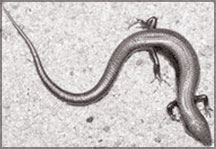Love them, they are harmless
by Sajitha Prematunge
It's said that there is no medicine for skink bites. In spite of all
this talk about skink bites being incurable and them being depicted as
horrible monsters in many nations, they are perfectly harmless and quite
intriguing. Skinks are not dangerous to humans or other animals and will
only bite if provoked.
Sri Lanka has an amazing diversity and highly endemic array of
reptiles, though only little research has been done on the taxonomy,
ecology and distribution of reptiles like skinks. The lack of clearly
illustrated publications, the similarity in their overall colour
patterns and the complex identification characters have resulted in
field identification often being confused.
|

Lankascincus sripadensis |
Two new species of skinks, Lankascincus sripadensis and Lankascincus
munindradasai has been discovered from Peak Wilderness Sanctuary by L.
J. Mendis Wickramasinghe, Roshan Rodrigo, Nihal Dayawansa and U. L. D.
Jayantha.
Lankascincus sripadensis is the largest member in the genus. The
Lankascincus is an endemic skink lizard genus that consists of six other
Sri Lankan skink species namely Lankascincus fallax, Lankascincus
deignani, Lankascincus taprobanensis, Lankascincus deraniyagalae,
Lankascincus gansi and Lankascincus taylori. The genus has a
distribution from coastal planes to central high lands that are at the
mercy of different climatic zones.
Although mostly found among leaf litter and are generally considered
to be terrestrial skinks of Lankascincus genus rarely display sub
arboreal behaviour. They lay two eggs at a time and hide them under
stones, debris or leaf litter. They have pointed heads, slender bodies
and strong short legs which can be considered as evolutionary
adaptations.
Lankascincus fallax is the type species of the genus, with a wide
distribution around the island.
The new species Lankascincus munindradasai, has a medium sized,
moderately long body and a depressed, narrow and elongated head distinct
from the neck; long snout and tail longer than the rest of the body. The
back of its head is dark brown with random black spots.
|

Dr Amith Munindradasa |
The back of its body is olive brown. Four longitudinally oriented,
irregular, broken lines that start from back of the neck diminish beyond
the base of its tail, very distinct in the mid dorsal area.
Another line starts from the back of the eye and diminishes towards
mid tail. The species is named after the late Dr. D. I. Amith
Munindradasa, the former Head of the Department of Electronics
Engineering, Moratuwa and scientist who worked for the betterment of the
country.
Although an electronic engineer by profession he worked in various
disciplines, a lover of nature, who was also involved in the discovery
of five gecko species previously carried in the Sunday Observer, and
worked as a silent yet effective conservationist.
The names assigned for the species in native languages Sinhala, Tamil
and English are respectively Munindradasage lakhekanala, Munindradasavin
arene and Munindradasa's Lanka skink.
The body of the Lankascincus sripadensis, the other newly discovered
species, is moderately long and robust, with a long, depressed and
narrow head distinct from the neck.
It also has a long snout and its eyes are larger than its ears, same
as Lankascincus munindradasai, and tail longer than the length of the
body.The back of the head of Lankascincus sripadensis is olive brown
with a longitudinally oriented mid-dorsal dark brown line starting from
the neck and diminishes beyond the base of tail.
Another line starts from the back of the eye and diminish towards the
mid tail. The dorsal sides of its limbs are dark brown with intermittent
white dots. Sripakandu duburu hekanala, Sivanolipathmalai arene and
Sripada forest skink are its Sinhala, Tamil and English names
respectively.
Peak Wilderness sanctuary, where these two new species were found has
the only uninterrupted forest cover of altitudinal graded forest types
ranging from lowland mixed Dipterocarp forests to Montane Cloud forests.
With forests ranging from Tropical Lowland Forests to Tropical
Montane Forests Peak Wilderness sanctuary is very significant for
richness in its biodiversity. Peak Wilderness, otherwise known as
Sripada sanctuary is a heaven for endemic and threatened bird species of
Sri Lanka.
But this sanctuary, the home to such an abundance of wild life, is
not immune to disruptive human activities such as over exploitation of
forest resources and discharge of pollutants. The area is also subject
to forest die back phenomenon and small land slides.
Every year, trees of the surrounding forest is felled illegally as a
source of building material for tea boutiques, leading all the way up to
Adams peak during the pilgrim season. The status of the skinks in the
endangered list is unknown.
If their habitat is at risk so are they. And just imagine how many
other new species await their discovery in our country's pristine
wilderness.
[email protected]
|
